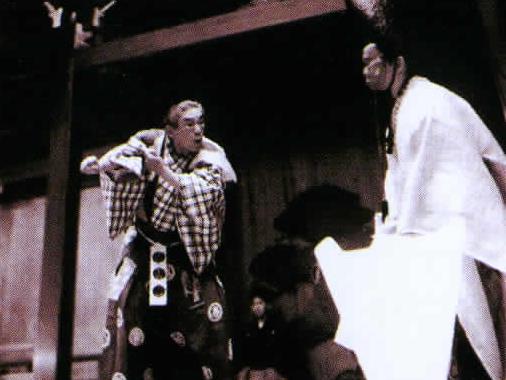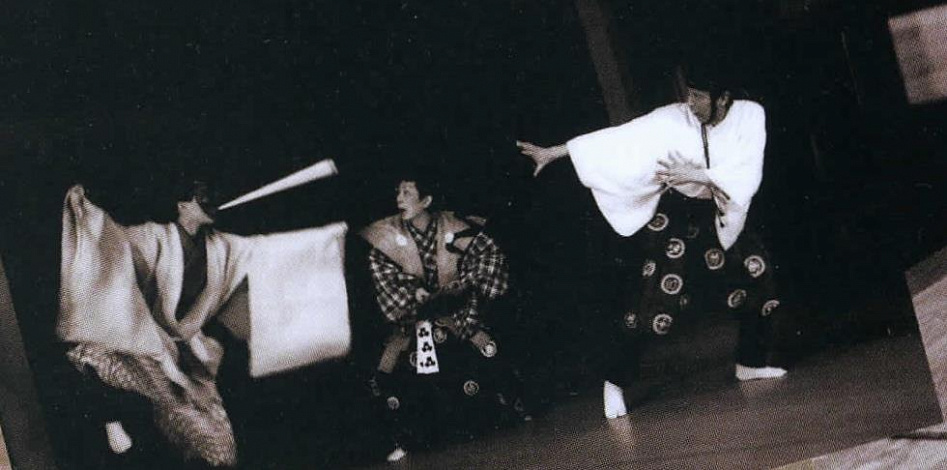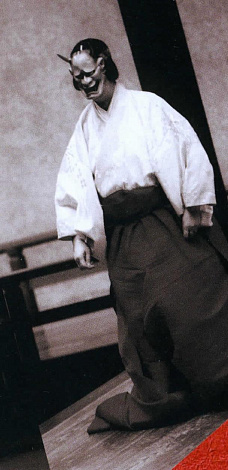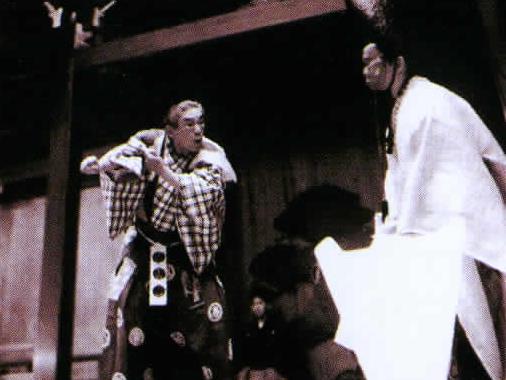| Kyogen Cast: | Shime Shigeyama, Doji Shigeyama, Masakuni Shigeyama, Ippei Shigeyama |
| Theatre Noh Cast: |
Hideo Kanze, Kosuke Tcrasawa, Kan Hosho, Takayuki Isso, Genjiro Okura, Shinnosuke Kawamura, Bunzo Otsuki, Shinya Umewaka. Hiromichi Yamamoto. Noboru Aida. Yukinori Takao, Akihiro Takao. Naotaka Kakuto, YasuyukiTaketomi. Yoshihide Akamatsu, Masamichi Yamazaki |


“Kyogen” (literally “mad words”) are small comic plays. The sources of the “kyogen" tradition go back to China of the 8th century, whence this form of folk theatre moved to Japan. As a result of the development of this tradition in Japan there was a special form of theatre art - “sarugaku” (literally “game of monkeys”), which became the prototype for the future Noh drama. The comic elements of “sarugaku" representations developed in the 14th century into kyogen, a national comic drama genre. Already at the beginning of the 14th century there was a division between actors of the serious plays of Noh theatre and those actors playing the repertoire of kyogen, which consisted of simple, popular farces.
At the same time, the kyogen tradition was a component of the Noh theatre. Already then there was a type of representation in which, during the intervals between the plays of high content (jokoku), they began to show short, cheerihl interludes with the participation of three or four actors, lasting for 10- 15 minutes only. Tire neighboring presence on one stage of farces with jokoku plays became an important reason for the literary influence on the content. Early farces included more songs and dances, while the later ones attribute an important role to dialogue and intrigue. The oral tradition of kyogen plays led eventually to the written collection of over 200 plays, whose authors are unknown. The heroes of kyogen were close to the spectators due to their easy recognition: the cunning servant, the street dealer, the unfaithful wife and the jealous husband, the ruined Samurai and the exorcist - charlatan are types of kyogen. The Poor is resourceful and cheerful, the Rich is silly and greedy
Today the farces of kyogen are no longer considered as a minor phenomenon; moreover, this art continues to enjoy great popularity with spectators. For several centuries, until the period of Meiji Restoration (1868), kyogen was under the protection of the military aristocracy. Then the tradition of kyogen was maintained by family collectives, first of all by the schools of Izumi, Okuri and Shigeyami. Nowadays professional actors of kyogen act in farces both inside and outside of performances of Noh Theatre.
Noh Theatre - modem Japanese theatre is diverse and includes the most different theatrical forms, fr om traditional to modem, including western. Noh Theatre, like Kabuki and Bunraku, is one of the major classical scenic arts of Japan. The Noh Theatre unites elements of dance, drama, music and poetiy to a highly sophisticated scenic art. Originally Noh performances were performed on religious holidays.
The peak of Noh was reached in the 14th century, during the Japanese Middle Ages under the protection of military leaders and the master of “shogun”. Its aesthetic principles have been developed and expressed by the outstanding actor and playwright Kan'ami (1332-1384) and his son Zeami (1363-1443).
Only men can be actors, and those actors who play female roles frequently wear masks. The basic role in the Noh play is called “shite”, the hero appears with one or several people who accompany him, called “tsure”. In many plays the “shite” appears in first half of the play as a usual person, and in the second half in his/her genuine form, a spirit or a ghost of a time passed. At his first appearance the hero is called “mae shite”, at the second "nochi shite”.
Supporting roles, the so- called "waki” are usually intended for the travelling priests, who asks questions of the “shite” and thus hears the story of surrounding events. The chorus sits on the side of the stage and narrates the events that happened before, and also explains ideas and emotions of the main character. The musicians, called "hayashikata”. provide musical support by playing a flute and drums.
During the 17th-19th centuries there was a long process of the formation of the scenic space for Noh Theatre. Today its structure is an established canon. Above the main stage a bent roof rises, similar to a temple, which covers also the side stage and the backstage. The bridge “hashigakari” connects the main stage to a slightly elevated comer, whence actors and musicians enter and leave. On the back wall the sacred pine is represented, wh ere, according to the belief. God descends.
Nowadays performances of Noh theatre take place in modem buildings, but the traditional classical form of the stage is preserved


